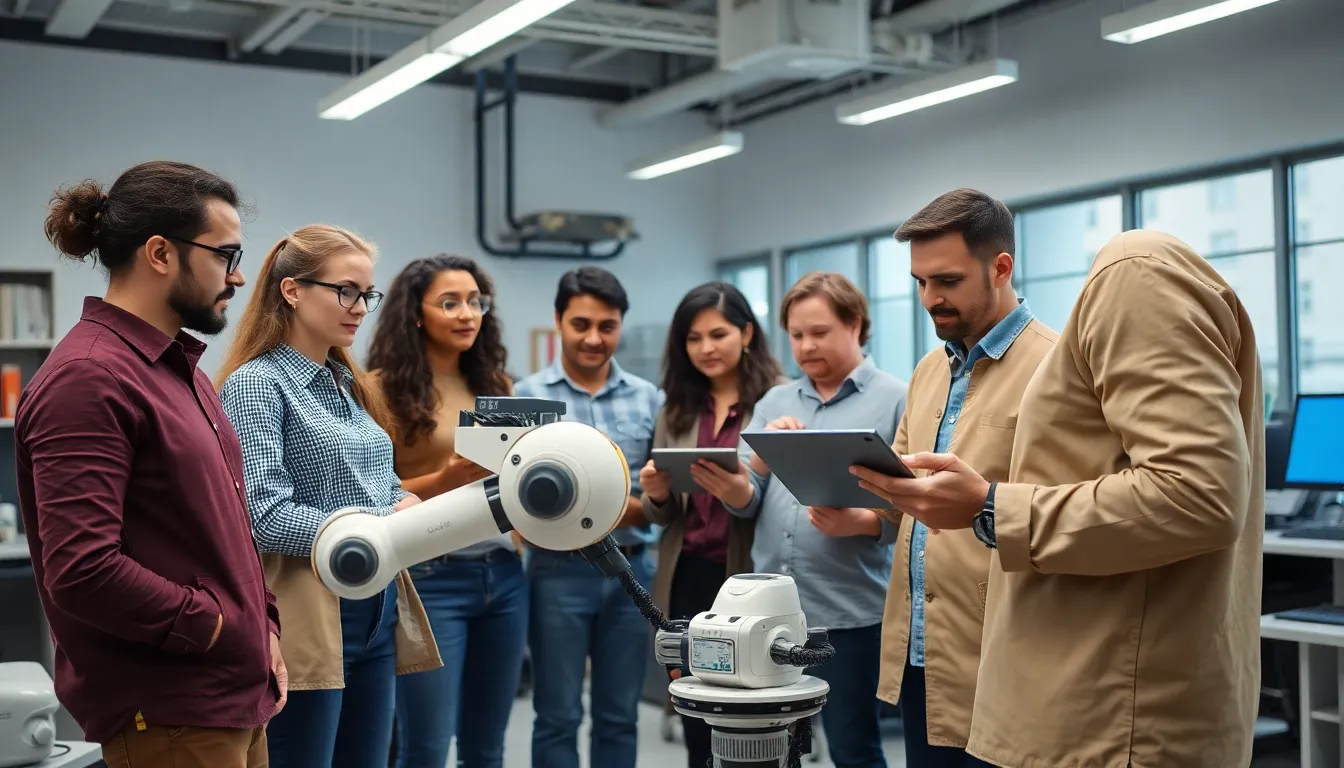In a world where robots are no longer just the stuff of sci-fi movies, the integration of robotics into intelligent systems is revolutionizing industries faster than you can say “artificial intelligence.” These advanced machines aren’t just here to vacuum your living room; they’re transforming everything from healthcare to manufacturing, making processes smarter and more efficient.
Table of Contents
ToggleOverview of Robotics in Intelligent Systems
Robotics integrates seamlessly with intelligent systems to enhance functionality and decision-making. These systems leverage advanced algorithms and machine learning to process vast amounts of data, enabling them to operate autonomously. In environments like healthcare, robots assist in surgeries and patient care, drastically improving precision and outcomes. Manufacturing sectors utilize robotic arms and automated processes, boosting productivity while minimizing human error.
Intelligent systems, powered by robotics, also contribute to data analysis and real-time monitoring. Robots equipped with sensors can analyze their surroundings and make decisions based on environmental feedback. Such capabilities allow for applications in areas like agriculture, where autonomous drones monitor crop health and optimize resource usage.
Robotics in intelligent systems enhances safety and efficiency, especially in hazardous work environments. Robots can perform tasks in dangerous settings, reducing risks to human workers. In logistics, autonomous vehicles streamline delivery processes, optimizing routes, and minimizing delivery times.
Establishing connections between robotics, machine learning, and artificial intelligence furthers innovation. The combination of these technologies leads to smarter, more adaptable systems. Industries now prioritize robotics for automating repetitive tasks, allowing human workers to engage in more complex and creative activities.
With ongoing advancements, robotics in intelligent systems continues to evolve, offering new solutions to various challenges. Collaborative robots, or cobots, work alongside humans, enhancing teamwork and productivity. Such developments highlight the transformative potential of robotics in shaping future intelligent systems across multiple sectors.
Key Technologies in Robotics

Robotics heavily relies on advanced technologies to enhance its capabilities within intelligent systems. This section highlights key technologies driving this innovation.
Artificial Intelligence Integration
Artificial intelligence (AI) plays a critical role in robotics. It enables machines to process vast amounts of data and make informed decisions autonomously. Natural language processing allows robots to understand and respond to human commands effectively. Moreover, computer vision facilitates the recognition of objects and navigation in various environments. These AI advancements improve the functionality of robotic systems, particularly in sectors such as healthcare and manufacturing. By incorporating intelligent algorithms, robots can optimize workflows and adapt to changing conditions. Thus, AI integration fuels the growth and versatility of robotics.
Machine Learning Applications
Machine learning empowers robots to learn from their experiences. Algorithms analyze data and identify patterns, which enhance decision-making capabilities over time. This technology is especially influential in predictive maintenance, where robots anticipate failures based on historical performance data. Additionally, autonomous vehicles utilize machine learning for real-time navigation and obstacle avoidance. Usage in agriculture includes monitoring crop health and optimizing resource application based on data analysis. As machine learning continues to advance, its applications in robotics broaden, driving efficiency and innovation across multiple sectors.
Current Applications of Robotics in Intelligent Systems
Robotics increasingly plays a vital role in intelligent systems across various industries. Notably, it enhances operational efficiency and decision-making through integration with advanced technologies.
Industrial Automation
Robots significantly transform manufacturing processes by automating repetitive tasks. Companies employ robotic arms to handle assembly lines, which improves precision and reduces human error. Additionally, collaborative robots work alongside human workers, creating a safer and more efficient work environment. Sophisticated systems equipped with predictive maintenance capabilities monitor machinery and preemptively address issues. Data analytics from robotics helps optimize supply chain management, resulting in reduced operational costs. As industries embrace automation, robotics fosters enhanced productivity and encourages innovation.
Healthcare Innovations
Robotics in healthcare leads to groundbreaking advancements in patient care and surgical procedures. Surgical robots assist surgeons, providing enhanced accuracy and minimizing recovery times. Robots also play a critical role in telemedicine, enabling remote consultations and monitoring. Moreover, rehabilitation robots help patients regain mobility after injuries by offering customized therapy experiences. Assisted living robots care for the elderly, providing companionship and support in daily activities. Integrating robotics with AI improves patient outcomes, demonstrating the profound impact of robotics on the healthcare landscape.
Challenges in Robotics Development
Robotics development faces several challenges that impact its integration into intelligent systems.
Technical Limitations
Robotic systems often encounter issues with hardware and software compatibility. Limited processing power constrains complex task execution and real-time decision-making. Furthermore, sensor accuracy impacts a robot’s ability to perceive its environment accurately. Difficulties in creating seamless communication protocols among devices hinder collaborative efforts within robotic frameworks. Significant advancements in machine learning algorithms enhance performance, yet they require substantial computational resources. Progress in battery technology also remains a limitation, affecting the operational duration of mobile robots.
Ethical Considerations
Ethical dilemmas arise with the deployment of robots in society. Concerns about job displacement surface as automation replaces traditional roles in various sectors. Privacy issues loom large, especially with robots equipped with surveillance capabilities. Unclear accountability in the event of robotic malfunctions complicates legal frameworks. Moreover, biases in AI algorithms can lead to unfair treatment in decision-making processes. Designers must prioritize transparency to foster public trust in robotic systems. Addressing these ethical considerations ensures responsible development and deployment of robotics in intelligent systems.
Future Trends in Robotics in Intelligent Systems
Emerging trends in robotics within intelligent systems focus on enhanced automation and collaboration in various sectors. Collaborative robots, known as cobots, increasingly work alongside human operators. They augment human capabilities by taking on repetitive tasks, allowing workers to engage in higher-level functions.
Advancements in artificial intelligence upgrade robotic efficiency. AI algorithms become more sophisticated, enabling robots to process complex data and make informed decisions. In healthcare settings, robots utilize AI to evaluate patient conditions and perform precise surgical procedures, leading to better outcomes.
The agricultural sector sees the rise of autonomous robots. These machines monitor crop health, optimize resource usage, and enhance yield efficiency. Drones equipped with AI analyze large fields, detecting issues early and ensuring timely interventions.
Real-time data analysis plays a significant role in logistics management. Robotics enhances supply chain efficiency, automating inventory management, and reducing operational costs. This trend leads to increased productivity and minimized human error across industries.
Furthermore, advancements in natural language processing improve robotic communication capabilities. Robots increasingly understand and respond to human speech, making them more user-friendly. Interaction with robots becomes more intuitive, facilitating their integration into daily life.
Ethical considerations drive the evolution of regulations governing robotics. Policymakers prioritize developing standards that balance innovation and accountability. This approach addresses concerns related to job displacement and privacy, fostering public trust in robotic technologies.
As robotics continues to evolve, the logistical and operational landscape transforms comprehensively. The focus on sustainability emerges, with robots adapting to minimize environmental footprints. These trends highlight the dynamic shifts enabled by robotics in intelligent systems across multiple sectors.
The integration of robotics with intelligent systems is undeniably reshaping various industries. As these technologies advance, they offer unprecedented opportunities for efficiency and innovation. The collaboration between humans and robots is enhancing productivity while addressing complex challenges across sectors like healthcare and manufacturing.
By harnessing the power of AI and machine learning, robotics is not just automating tasks but also improving decision-making processes. The future promises even greater advancements as ethical considerations and regulatory frameworks evolve to ensure responsible deployment. Embracing these changes will be essential for organizations aiming to thrive in an increasingly automated world.


